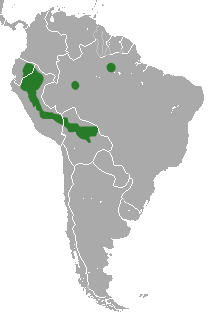Glironia
| Bushy-tailed opossum | |
|---|---|
| Scientific classification | |
| Kingdom: | Animalia |
| Phylum: | Chordata |
| Class: | Mammalia |
| Order: | Didelphimorphia |
| Family: | Didelphidae |
| Subfamily: |
Glironiinae Voss & Jansa (2009) |
| Genus: |
Glironia Thomas, 1912 |
| Species: | G. venusta |
| Binomial name | |
|
Glironia venusta Thomas, 1912 |
|
 |
|
| Range of the bushy-tailed opossum | |
| Synonyms | |
|
G. aequetorialis H. E. Anthony, 1926 |
|
G. aequetorialis H. E. Anthony, 1926
G. criniger H. E. Anthony, 1926
The bushy-tailed opossum (Glironia venusta) is an opossum from South America. It was first described by English zoologist Oldfield Thomas in 1912. It is a medium-sized opossum characterized by a large, oval, dark ears, fawn to cinnamon coat with a buff to gray underside, grayish limbs, and a furry tail. Little is known of the behavior of the bushy-tailed opossum; less than 25 specimens are known. It appears to be arboreal (tree-living), nocturnal (active mainly at night) and solitary. The diet probably comprises insects, eggs and plant material. This opossum has been captured from heavy, humid, tropical forests; it has been reported from Bolivia, Brazil, Colombia, Ecuador and Peru. The IUCN classifies it as least concern.
The bushy-tailed opossum is the sole member of Glironia, and is placed in the family Didelphidae. It was first described by English zoologist Oldfield Thomas in 1912. Earlier, Glironia was considered part of the subfamily Didelphinae. A 1955 revision of marsupial phylogeny grouped Caluromys, Caluromysiops, Dromiciops (monito del monte) and Glironia under a single subfamily, Microbiotheriinae, noting the dental similarities among these. A 1977 study argued that these similarities are the result of convergent evolution, and placed Caluromys, Caluromysiops and Glironia in a new subfamily, Caluromyinae. In another similar revision, the bushy-tailed opossum was placed in its own subfamily, Glironiinae.
...
Wikipedia

